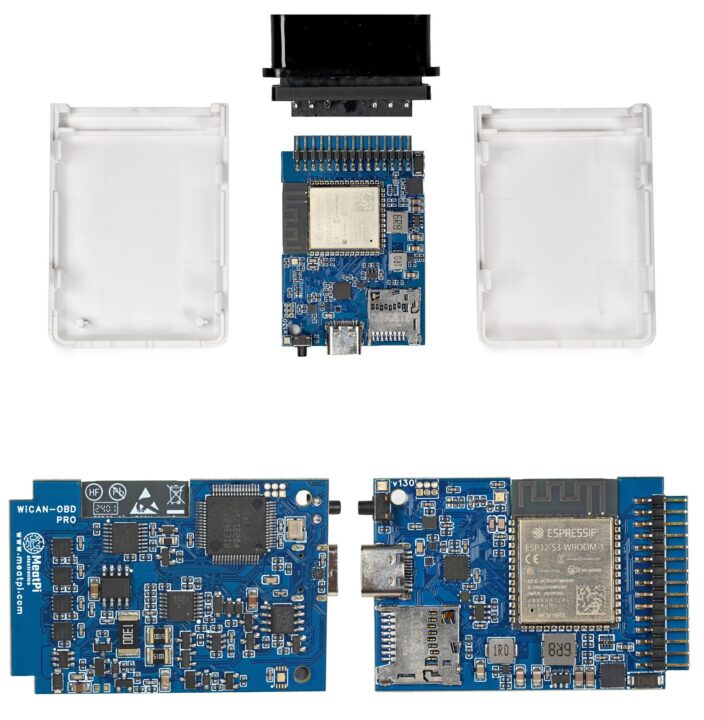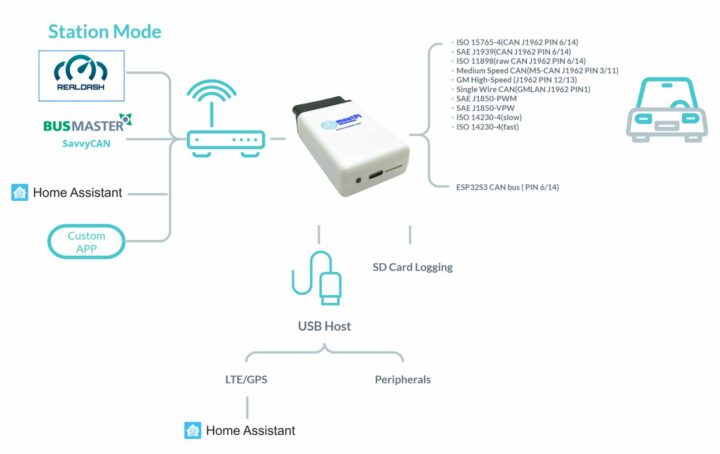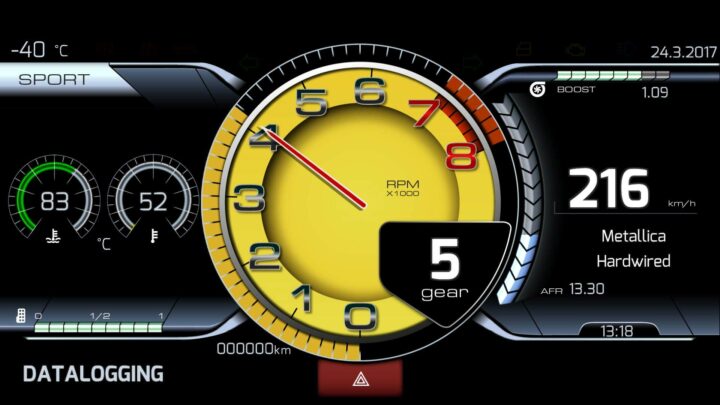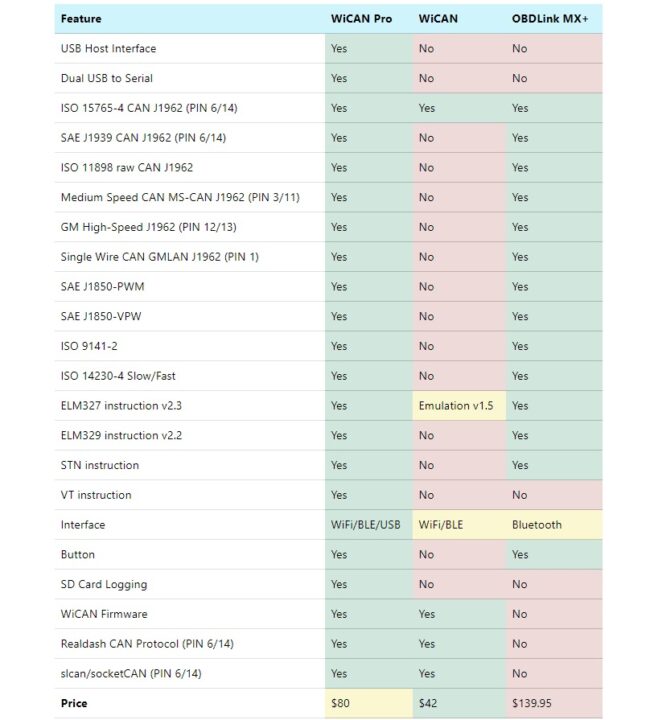MeatPi Electronics introduced the WiCAN Pro, an ESP32-S3-based OBD scanner, and the successor to WiCAN-OBD. Equipped with an OBD-II interface IC, it provides full support for all legislated OBD-II protocols. It offers compatibility with multiple CAN Bus protocols, including three standard CAN Bus and single-wire CAN Bus.
The previous generation WiCAN module came in an OBD or USB-based version. The WiCAN Pro only has an OBD interface, but another significant difference from the previous product is that it features a USB host port. This port can power USB devices up to 1.5 amps at 5 volts and enables capabilities like adding GPS or cellular-based radios, like with meatPi’s ESPNetLink add-on.
WiCAN Pro specifications:
- Wireless Module – ESP32-S3-WROOM-1-N16R8
- SoC – Espressif Systems ESP32-S3R8 dual-core Tensilica LX7 @ up to 240 MHz with vector instructions for AI acceleration, 512KB RAM, 8MB PSRAM
- Storage – 16 MB flash
- Wireless – 2.4 GHz WiFi 4 and Bluetooth
- PCB antenna
- USB – USB Type-C female connector for flashing ESP32 and optional peripherals such as LTE or GPS
- Supports all OBD-II protocols with a dedicated chip
- ISO 15765-4 CAN J1962
- SAE J1939 CAN J1962
- ISO 11898 raw CAN J1962
- Medium Speed CAN MS-CAN J1962
- GM high-speed J1962
- Single Wire CAN GMLAN J1962
- SAE J1850-PWM
- SAE J1850-VPW
- ISO 9141-2
- ISO 14230-4 slow/fast
- Compatible with multiple instruction sets
- ELM327 instruction v2.3
- ELM329 instruction v2.2
- STN instruction
- VT instruction
- RTC for accurate timekeeping
- MicroSD card logging
- Multi-function push button
The WiCAN Pro plugs into the vehicle’s OBD port and is powered by the vehicle’s battery. The voltage range is 6.5V to 18V, consuming about 35mA during operation and 2.8mA in sleep mode.

The device includes dual UARTs, one dedicated to flashing and debugging the ESP32-S3 and the other configurable for sending commands to the OBD chip, providing flexibility for developers working on custom automotive applications. According to the product page, WiCAN Pro can be integrated with Home Assistant and other IoT applications without requiring external apps. This feature enables users to incorporate vehicle data into a smart home ecosystem, allowing for automated vehicle diagnostics and monitoring.

The ESP32-S3-based OBD scanner WiCAN Pro runs on the versatile WiCAN firmware, which is already available and runs on an ESP32. This firmware can send MQTT messages about the vehicle’s health, integrate with Home Assistant, or drive a RealDash display with real-time information. Moreover, this open-source device is compatible with a range of established OBD diagnostic apps including Car Scanner, Torque Lite or Pro, OBD Auto Doctor, BimmerCode, and OBD Fusion.

The company also offers a feature comparison between the WiCAN Pro, WiCAN, and the OBDLink MX+.
The WiCAN Pro campaign launched on Crowd Supply and has raised $6,000 so far with 35 days remaining. The product is priced at $80, with an additional $8 for U.S. shipping and $18 for international shipping. Deliveries are expected to start by mid-February 2025.

Sayantan Nandy, an electronics engineer with over four years of hands-on experience in PCB design, circuit development and power electronics, is proficient in EAGLE CAD, Ki-Cad, and Altium. He has a proven track record of delivering efficient and effective systems. His expertise extends from R&D, and prototyping to production support, making him a valuable asset to any engineering team.
Support CNX Software! Donate via cryptocurrencies, become a Patron on Patreon, or purchase goods on Amazon or Aliexpress







haha very timely its obviously politically named meatPi, and “yes we can” from Obama 2008 slogan. Metallica and vehicles, a throwback.
to Joko Widodo outgoing pres of indonesia
We should probably get used to concept that amino acids are energy, because virtually all animals lack the enzymes to convert into them in any significant quantity, from sugar and fat. (as well as conversion into ammonia, but thats another chapter). thus, food supply and energy esp meat eggs and dairy as huge energy footprint.
One technical question … why is so much power necessary for GPS? there are some ultra low power options but im not understanding the design choice “why” behind this.
Some cellular modules can have high current peaks. The USB-C host port is designed to support different peripherals, possibly users own custom devices, so having a bit of extra juice can be useful.
Retired mechanic. Forty years of embedded development. Ten years embedded device security including certificate image signing and on chip firmware validation. Still do all my own car work. Use OBD-II for diagnostics.
There is no way I am plugging a WiFi connected adapter into my OBD-II port. Sorry, no way. Huge security hole. All you need is to be rolling down the highway and have someone following you run an ABS purge and open the throttle.
Who will be following you that can force open the WiCAN AP then proceeds to crack wpa3 encryption. Then do ABS purge over the OBD port(not sure this is even possible on modern cars). I understand you’re worried about security, but if someone goes through all this trouble to get you then I’m sure there’s easier way 🙂
Isn’t the drive by wire part on a different CAN network then the ODB2 plugs in to?
Chances are you’ve already got similar points of entry on your modern automobile.
Could you please release a OVMS firmware build for your esp32 based devices? And perfectly a PR to OVMS project adding hardware support for your device. OVMS is now finally getting ESP-IDF v5 and would support esp32-S3, esp32-C3 and so on.
Would be awesome to use your hardware with just the plain OVMS firmware. There are people who do not need a celular modem or GPS build into the obd2-dongle and your esp32 hardware fullfills exacty the needs of those people who just want to run ovms to debug their cars.
Isn’t the drive by wire part on a different CAN Eps abs BCM key smart key smk mbfm air bag tcm &car tools gps network then the ODB2 plugs in to
Mohammad,
Both the high speed network (drive by wire, steer by wire, abs, engine and transmission control) and the low speed network (diagnostic controls, climate control, instrumentation, A/V control, windows, lights, etc.) are available at the OBD port.